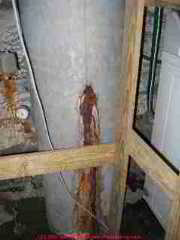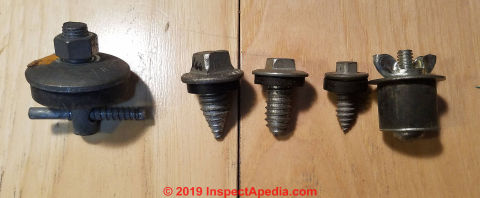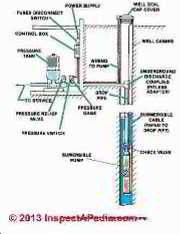 Well Tank / Water Tank Air or Leak Repairs
Well Tank / Water Tank Air or Leak Repairs
Water Pressure Tank / Water Tank Diagnosis & Repair for Air Charge, Water Tank Leaks, Rust, Corrosion, Sweating
- POST a QUESTION or COMMENT about well water tanks: types, diagnosis, installation, repair, & replacement of water pressure tanks
Water tank repair or replacement guide:
The water tank troubleshooting article series beginning here describes how to determine if you need to replace the water pressure tank.
Synonyms for water pressure tank include: water tank, water storage tank, well tank, pressure tank, pressure control tank, Extrol, WellXTrol, bladder tank, bladderless water tank.
InspectAPedia tolerates no conflicts of interest. We have no relationship with advertisers, products, or services discussed at this website.
- Daniel Friedman, Publisher/Editor/Author - See WHO ARE WE?
Water Pressure Tank Diagnosis & Repair Advice
 Discussed here: How to diagnose & repair water tank or water pressure tank problems. Well pump & water tank diagnosis & repair procedures - do I need a new water tank or well tank?
Discussed here: How to diagnose & repair water tank or water pressure tank problems. Well pump & water tank diagnosis & repair procedures - do I need a new water tank or well tank?
Short cycling of a water pump
which is defined
at SHORT CYCLING WATER PUMP means that the water pump or "well pump" turns on and off too rapidly or too frequently when water is being run in the building.
[Click to enlarge any image]
If this is the problem with your water pump,
SHORT CYCLING CAUSES describes the most common causes of this problem.
SHORT CYCLING DIAGNOSIS TABLE that lists all possible causes of well pump rapid cycling on and off.
If you are not sure what "water pump short cycling" means or how it is recognized,
read SHORT CYCLING WATER PUMP.
Intermittent water pump cycling
which is discussed
at WATER PUMP INTERMITTENT CYCLING when the water pump comes on for no apparent reason.
Loss of water pressure
means that the pressure with which water enters a plumbing fixture has become too slow, or is sometimes too slow or weak in water flow rate, or water flow may stop entirely.
See WATER PRESSURE LOSS DIAGNOSIS & REPAIR
Water tank leaks:
repairs for water leaking out of the water tank depend on where and why the leak is occurring. Leaks at threaded fittings might be repairable by draining the system, disassembly, cleaning and drying the parts, and re-assembly with an appropriate pipe sealant or in some locations teflon tape.
Other leaks due to rusting, perforating water tanks can be patched temporarily but you should expect to replace the water tank as soon as possible.
That's because corrosion in a water tank usually occurs from the inside out and will be more serious than what you see on the tank exterior.
Watch out: poking at or messing with what seems to be a tiny leak in the surface of a water tank, because the steel is probably rusted thin, risks converting the problem to an instant catastrophe and flood.
Steel Water Tank Rust Perforation & Emergency Tank Repairs
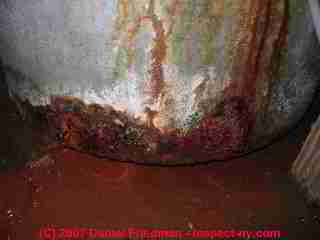
This steel water storage tank is leaking. When you see damage like this on a water tank, the perforation has rusted through from inside the tank. A tank that looks like this needs to be replaced.
Watch out: don't poke at rust like this on a water tank - you are likely to change a slow seep or drip into an immediate catastrophe - the steel around the site of rust perforation is usually quite thin.
Emergency temporary repairs to a leaky Water Tank
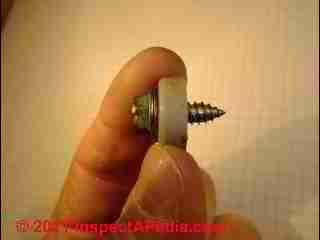 If the rust perforation on a steel, bladderless water pressure tank is very tiny, 1/8" or so, temporary repair can sometimes be made using a special short lag-type threaded screw with a neoprene washer. Leak repair screws are sold for this use.
If the rust perforation on a steel, bladderless water pressure tank is very tiny, 1/8" or so, temporary repair can sometimes be made using a special short lag-type threaded screw with a neoprene washer. Leak repair screws are sold for this use.
In an emergency you can even fabricate one of these water tank leak repair lag bolts, as we did for our photo (left).
We used a 3/4" long lag screw and a thick neoprene washer that happened to be around. If you buy a factory-made version of this device the washer is designed to seat and seal against the curved surface of the leaky water tank.
Watch out: because the steel will be thin around the rust spot, you may find that you need a larger screw than you thought, or bought.
We recommend buying several sizes of water tank repair screws, but start by using the smallest one that will be secure when screwed all the way in to the tank.
Below we show an assortment of typical plugs used to make a temporary patch on a leaky water tank.
The left-most tank repair or patch device is intended for larger holes. The "tee" screw is inserted into the hole and then the assembly tightened by the top bolt. The three middle lag-screw type plugs are simply screwed into smaller rust or other perforations in the water tank. Start with the smaller screw and if you can screw it up tight to stop the leak, quit there.
If however you cannot screw the plug tightly to the tank surface, remove it and move to the next larger plug screw size.
The right-most expansion plug is not intended for tank leak repairs; rather it is an expanding pipe plug that can be used when pressure testing water or other piping.
In our OPINION such repairs are temporary at best and you need to beware that the repair spot may leak again soon.
Just blob on some sealant to stop a leaky water tank?
A second type of water pressure tank repair that might work in some locations is the use of quick-setting epoxies, caulks, sealants, including those that can work in wet conditions.
Details are at CAULKS, NONTOXIC
You still need to replace the water tank but this approach can stop or slow a leak while you wait for the new tank to be installed.
This approach would not work on the horribly rusted water tank shown above - that one is just too far gone.
Water Tank Leaks Leak Water Out or Air Out, depending on the Leak Location
Leaks like the ones in the above photos can also leak the air charge out of the upper portion of the tank when the in-tank water level is below the leak point. A water pump short cycling problem could be due to an air loss in the tank to a leak in the tank itself.
Reader Question: Do I Need a New Water Tank? - should I replace my old water tank?
We just had our pump replaced after 18 years. Total cost with tax was $2400. Project was done on emergency basis on a Friday night and we were really stuck. During his visit the plumber/owner suggested we consider a larger pressure tank than our 20 gallon unit, also recently replaced.
The system worked well for many years and I don't see the need to purchase another larger tank. Any thoughts? - Wayne Ouellette
Reply: You may not need a new water pressure tank.
If your water tank is a newer bladder type, even a smaller 20-gallon tank gives the equivalent of a larger old style (non-bladder) tank in the draw-down cycle - the amount of time that you can run the water before the pump has to come on.
As long as your pump is not WATER PUMP SHORT CYCLING (which may shorten pump life), the gain from a larger tank is probably not much. If your tank is an older type with no internal bladder, the reason to go to a newer tank would be reliability and reduced maintenance.
Some Reasons to Consider a New Water Tank
- Leaks:
The water tank is perforated, damaged, or leaking - you need a new one - Bladderless water tank:
The water pump has
constant WATER PUMP SHORT CYCLING problems
and the water tank is an older non-bladder type you can reduce the frequency of water tank maintenance (adding air) and eliminate problems with automatic air volume controls that try to add air for you by installing a new bladder type water pressure tank.
At WATER TANK TYPES: WATER, OIL, EXPANSION, ALL we explain the different types of water tanks. - Limited well water:
Your well has a poor flow rate and you often run out of water.
Less costly than drilling a new well is the addition of greater water storage capacity in one or a series of larger water tanks.
But first see WATER PRESSURE LOSS DIAGNOSIS & REPAIR, and
see WATER PRESSURE PUMP REPAIR GUIDE.
Watch out: before you go to the trouble and expense of replacing a water pressure tank, make sure that you have correctly diagnosed the problem that you are "curing" - you wouldn't want to replace a water tank only to find that you still have the water pressure or quantity problem because another, perhaps less costly, part was at fault.
Also
see WATER TANK LIFE & REPLACEMENT.
The illustration at page top is courtesy of Carson Dunlop Associates, Inc. in Toronto.
Check other water pump and pressure problems before replacing expensive parts - Before assuming that a water problem is due to the pump or well itself,
see WATER PUMP REPAIR GUIDE a specific case which offers an example of diagnosis of loss of water pressure, loss of water, and analyzes the actual repair cost.
Question: my well pump runs all the time our irrigation system is running
I'm told that when my irrigation system comes on my pump should run the whole time I'm watering. My thoughts were that the well will cycle and turn on at 30-psi and turn off at 50-psi letting the pump rest while the bladder distributes the water until gauge drops to 30-psi and the pump turns back on the the cycle keeps going.
Please let me know the correct answer, - Mike 6/18/11
Reply:
Mike: with so little information, I can't promise that I can give the correct answer, but certainly I wouldn't give you an incorrect answer on purpose.
The irrigation pump is a separate unit from your well pump, right?
If so it will run all the time you are watering but your well pump will turn on and off as needed.
If your irrigation system and house water run off of the same water supply system, then either the irrigation system fast enough that the pump never reaches cut-off pressure (entirely possible), or your water usage rate is faster than the well inflow rate and a tailpiece in the well is limiting the flow out - leaving the pump running all the time.
Question: I have no water and the switch or pump keep humming
errr i have no water and it sounds like the switch is trying to kick in by making like a hummimg sound and my pressure gauge says 0 so i have replaced the switch and the gauge and still nothing any thoughts in what i can do next to try to get some water? - Jenn 7/11/11
Reply:
Jenn:
Is your pump above ground or in the well. If the humming is coming from an aboveground pump and the pump is not running it is either jammed or is having trouble starting.
Watch out: shut off the power to avoid burning up the pump motor.
If it's a motor start problem, a hard-start capacitor kit might do the trick.
Question: My pressure tank has a pinhole leak - can this be repaired?
My pressure tank has a very small pin hole . Can the pressure tank be welded or sealed in anyway , or will the tank need replaced completely ? - Tom A. 8/11/11
Reply:
Yes, Tom. At your local hardware store you can probably purchase a special screw and washer part (less than $5.00. U.S.) intended to temporarily fix pinholes in water pressure tanks.
Watch out though: often a pinhole on the exterior wall of the tank will be found to be a bigger hole when you start messing with it - because the tank is corroding from the inside (usually) the area of thin walled steel may be bigger than you think.
Buy several repair screws of varying size and start with a small one to see if that can screw in tightly enough to stop the leak. If it won't, you'll need to use a larger screw.
Welding is technically possible but not economical, and a repair epoxy might work with good surface cleaning provided you could take the tank out of service long enough and keep it dry during the gluing process, but like the little Dutch boy with a finger in the surface of the dike, that's not the most reliable repair.
Figure a new water tank is in your future.
...
Reader Comments, Questions & Answers About The Article Above
Below you will find questions and answers previously posted on this page at its page bottom reader comment box.
Reader Q&A - also see RECOMMENDED ARTICLES & FAQs
On 2023-05-10 by InspectApedia Editor
@Sam,
Thank you for this follow up, helpful to hear. Glad it's fixed.
On 2023-05-10 by Sam
@InspectApedia Editor ,
It was my pump, replaced and all is well.
Thank you InspectApedia Editors
On 2023-05-09 by InspectApedia Editor
@Sam,
Thank you as well for the kind words. Let us know what you're told - what's found, as that will help other readers, too.
On 2023-05-09 by Sam
@InspectApedia Publisher,
Thank you very! I hope that’s what it is.
I have a well tech coming tomorrow morning .
Thank you again, what a great service you give.
On 2023-05-09 by InspectApedia Publisher - an electrician or pump installer can do a simple electrical test to see if the pump motor itself is shot
@Sam,
Try replacing the pressure control switch with a new one.
A 30/50 unit.
A handyman who knows how to work safely on electrical wiring or an electrician can do it.
If a new switch doesn't work, an electrician or pump installer can do a simple electrical test to see if the pump motor itself is shot
We give the water pump pressure control switch settings as
CUT-IN / CUT OUT
CUT-IN is the pressure at which the pump turns on.
CUT-OUT is the higher pressure at which the pump turns off.
On 2023-05-08 by Sam
@InspectApedia Editor , thanks for the fast reply. I think it’s pump related, I turned on the faucet at 30 psi the switch triggered but the pump did not turn on then pressure fell to zero. I called professionals but unfortunately they won’t be here to next week.
The switch is a 50/30. Thanks again, Sam
On 2023-05-08 by InspectApedia Editor - if your pressure falls to zero - no water is flowing - it means that the pump isn't turning on
@Sam,
Oops - don't feel bad, you're one of thousands who've fallen into the "I ran out the well" difficulty. (Voice of experience)
The fact that your pressure falls to zero - no water is flowing - means that the pump isn't turning on.
That might mean the pressure switch is debris-clogged (replace it) Or the tank pressure is set too high.
With NO water pressure in the system and the pump OFF, set your water tank air charge to 2 PSI below the pump pressure switch CUT-IN pressure.
Eg 28 psi into an empty tank would be right if the pump turns on at 30 psi.
On 2023-05-08 by Sam
Hello, I think I ran my well dry yesterday while using more water at one time than I ever have. My tank PSI was low at 10psi, I added to 28 psi and holding
If I shut the main valve off the pressure builds to 50 I then open the valve slowly and it will hold pressure but goes to zero after 2 toilet flush. Any ideas.
Thank you very much for the help.
On 2022-11-21 by InspectApedia (Editor) - Can poor water pressure result in a brand new washer to not work properly
@JoAnn,
That's very interesting and not knowing all possible circumstances I can't give you a definite no, but in general most washing machines have a water level sensor so the washing machine will simply wait until, during a fill cycle, water reaches the level specified by the control settings.
It shouldn't matter whether that takes more or less time as long as eventually it gets enough water. On the other hand if you run out of water completely, which can certainly happen with a low flow rate well, then you're washing machine performance is unpredictable.
On 2022-11-21 by JoAnn
Can poor water pressure result in a brand new washer to not work properly by not going thru its cycles
On 2022-08-18 by InspectApedia (mod) - My jet pump is short cycling and will not stop
@Justin nelson,
Take a look at the causes and cures listed at
COMMON CAUSES OF WATER PUMP SHORT CYCLING
Watch out: overcharging a water tank with very high air pressure is very dangerous and could cause a water tank to burst, causing severe injury.
Please let us know what you find and if you have additional questions.
On 2022-08-18 by Justin nelson
My jet pump is short cycling and will not stop. Even when I take the little line that goes to the contacted off it will still short cycle until I flip the breaker. I've changed the foot valve, removed and cleaned the venturi and leak tested the lines with air. I've also checked the impeller and housing for leaks or damage.
The system is under extreme pressure when I take off the square bolt where u would add water it explodes out..please help
On 2022-05-27 by InspectApedia (mod)
@Don,
If the pressure is you seen the tank or changing in response to the pump in a sensible way then your surmise is reasonable. If not, I suspect the gauge.
On 2022-05-26 by Don
That's right. So I presume I should replace the main shut-off tap as it's probably defective? Also, becuase the tank is pressurizing, I can assume that the bladder is functioning properly? Thanks.
On 2022-05-26 by InspectApedia (mod) - pressure tank is definitely pressurized but no water is delivered at the fixtures
@Don,
If I understand correctly that the pressure tank is definitely pressurized but no water is delivered at the fixtures,
Then I would be looking at the main shut off between the pressure tank and the rest of the building.
On 2022-05-26 by Don
My convertible jet pump turns on, fills the pressurized water tank (with a bladder), and shuts down once the tank has filled. The tank's initial air pressure before being filled with water is 28 psi and 45 psi once filled with water by the pump at the time it stops.
All shut-off taps on the line delivering water from the tank to the cottage are open, yet no water flows from the tank through the deleivery line. The water system is used only during the warm months and shut down and drained completely in the late fall for the winter.
I've used the system in this manner for years with no problems until now. I also just replaced the foot valve. Any idea(s) what the problem(s) is/are? Thanks
On 2022-01-11 by Inspectapedia Com Moderator - "My holding tank went dry"
@Sarah,
Are we really discussing a "holding tank" (500-1000 gallons of water reserve) - or a more typical water pressure tank (that holds an equivalent of 20-30 gallons) ?
If no water entered a conventional pressure tank the problem is often a stuck bladder in the tank.
On 2022-01-09 by Sarah
My holding tank went dry. Never happened. I assumed my well went dry. Turned off well pump ordered water . Left holding tank pump on and tank was empty 48hrs later. Now I can turn holding tank pump on and off for use and tank doesn't go empty.
So I figure I have a break in the line from house to tank. right now Im hauling and managing running pump. Just tried the well pump to see if well refilled. Nothing,. After turning on well pump it kicked in about 60 seconds later then automaticallyturned off.
As opposed to the well being dry could the tank be too full to call because the float is sitting up in water? or am I sol dead well?
On 2020-02-09 by danjoefriedman (mod) - pressure tank seems to hammer hard at the cut out pressure of 50psi
Lyle
Please use the on Page search box to find our article. Series on
WATER HAMMER
Where we list? The common causes and suggest remedies. Most likely one of those is involved in the case. You describe.
On 2020-02-09 by Lyle
My pressure tank seems to hammer hard at the cut out pressure of 50psi. Cut in pressure is set at 30psi. What would cause this excessive hammering as it has just started a couple of days ago
On 2018-11-17 by danjoefriedman (mod) - pressure tank pressure will increase up to the pressure control switch CUT OUT pressure
Tony,
The pressure tank pressure will increase up to the pressure control switch CUT OUT pressure.
Typically if your pressure control switch turns the pump ON at 30 PSI it's going to turn the pump OFF at 50 psi. So 45 is reasonable.
On 2018-07-10 by Tony D.
Set tank pressure 2 lbs below switch kick-in @ 28 lbs. Pump kicks in @ 30 and out @ 45 lbs. Questtion: Is the tank pressure increased also to 45 lbs.? Kinda dumb question. But It doesn’t register so according to my pressure testing gauge.
...
Continue reading at or select a topic from the closely-related articles below, or see the complete ARTICLE INDEX.
Or seeWATER TANK REPAIR DIAGNOSTIC FAQs - questions and answers posted originally on this page
Or see these
Recommended Articles
- NO WATER PRESSURE
- WATER PUMP REPAIR GUIDE for a pump that won't start, won't stop, or that cycles too often or when it shouldn't
- WATER PUMP SHORT CYCLING CAUSES
- WATER TANK: USES, TROUBLESHOOTING - home
- WATER TANK DIAGNOSIS & REPAIR - home
- FIBERGLASS WATER TANKS, BLADDERLESS
- ROOFTOP WATER TANKS
- STEEL WATER TANKS, BLADDERLESS
- WATER PUMP SHORT CYCLING
- WATER TANK AIR, HOW TO ADD
- WATER TANK AIR INLET VALVE
- WATER TANK AIR LOSS SIGNS
- WATER TANK AIR PRESSURE ADJUSTMENT
- WATER TANK AIR VALVE REPAIRS
- WATER TANK AIR VOLUME CONTROL REPAIR
- WATER TANK BLADDERS
- WATER TANK BLADDER PRESSURE ADJUSTMENT
- WATER TANK BLADDER REPLACEMENT
- WATER TANK BLADDER STUCK to ITSELF
- WATER TANK DRAIN VALVE
- WATER TANK LIFE EXPECTANCY
- WATER TANK PERFORATION LEAK REPAIR
- WATER TANK PRESSURE CALCULATIONS
- WATER TANK PRESSURE RELIEF VALVE
- WATER TANK PRESSURE SELF-INCREASE
- WATER TANK RELATION to WATER PRESSURE
- WATER TANK REPAIR PROCEDURES
- WATER TANK LIFE & REPLACEMENT
- WATER TANK, ROOFTOP
- WATER TANK SAFETY
- WATER TANK SIZE & VOLUME
- WATER TANK vs WATER PRESSURE
Suggested citation for this web page
WATER TANK REPAIR PROCEDURES at InspectApedia.com - online encyclopedia of building & environmental inspection, testing, diagnosis, repair, & problem prevention advice.
Or see this
INDEX to RELATED ARTICLES: ARTICLE INDEX to WATER SUPPLY, PUMPS TANKS WELLS & SPRINGS
Or use the SEARCH BOX found below to Ask a Question or Search InspectApedia
Ask a Question or Search InspectApedia
Try the search box just below, or if you prefer, post a question or comment in the Comments box below and we will respond promptly.
Search the InspectApedia website
Note: appearance of your Comment below may be delayed: if your comment contains an image, photograph, web link, or text that looks to the software as if it might be a web link, your posting will appear after it has been approved by a moderator. Apologies for the delay.
Only one image can be added per comment but you can post as many comments, and therefore images, as you like.
You will not receive a notification when a response to your question has been posted.
Please bookmark this page to make it easy for you to check back for our response.
Our Comment Box is provided by Countable Web Productions countable.ca
Citations & References
In addition to any citations in the article above, a full list is available on request.
- Mark Cramer Inspection Services Mark Cramer, Tampa Florida, Mr. Cramer is a past president of ASHI, the American Society of Home Inspectors and is a Florida home inspector and home inspection educator. Mr. Cramer serves on the ASHI Home Inspection Standards. Contact Mark Cramer at: 727-595-4211 mark@BestTampaInspector.com
- John Cranor [Website: /www.house-whisperer.com ] is an ASHI member and a home inspector (The House Whisperer) is located in Glen Allen, VA 23060. He is also a contributor to InspectApedia.com in several technical areas such as plumbing and appliances (dryer vents). Contact Mr. Cranor at 804-873-8534 or by Email: johncranor@verizon.net
- Thanks to reader Wayne Ouellette for discussing water tank replacement needs May 2010
- Pumptrol® Pressure Switch Adjustment, Square D, Schneider Electric Corporation, 8001 Knightdale Blvd., Knightdale< NC 27545 1-888-778-2733 - Square D Technical Library, web search 07/24/2010 original source: http://ecatalog.squared.com/techlib/docdetail.cfm?oid=09008926800a93be
- 9013 Pumptrol® Commercial Pressure Switches Type F and 9013 Commercial Pressure Switches Type G, Catalog, SquareD, Schneider Electric Industries SAS, Schneider Electric Industries SAS, web search 02/23/2011, original source:
http://ecatalog.squared.com/pubs/Machine Control/
Pressure-Float-Vacuum Switches/Pressure Switches-Water and Air/9013CT9701.pdf
Square D is a brand of Schneider Electric. - Class 9013 Square D Commercial Pressure Switches: Water Pump Pressure Control Switch Class 9013, Type F, G, Manual, Square D Company, 8001 Highway 64 East, Knightdale, NC 27545-9023, USA, (919) 266-3671, www.squared.com,
web search 02/24/2011, original source: stevenengineering.com/tech_support/PDFs/45COM.pdf. Quoting:
The Type FSG, FYG, FRG - PUMPTROL® Water Pump Pressure Switches are used to control Water Pump Pressure Switches are used to control
electrically driven water pumps and have the following features:- The Type FSG is the standard water pump switch, suitable for all types of pumps: jets, submersible,
reciprocating, etc. - The Type FYG is designed to meet higher horsepower and pressure requirements.
- The Type FRG is reverse acting: the contacts open on falling pressure.
All are diaphragm actuated.
The Type G - PUMPTROL® Commercial/Light Industrial Pressure Switch is used to control electrically driven water pumps and air compressors. It has higher electrical ratings for direct control of motors in pump and compressor applications. The Type G switch is diaphragm actuated and has contacts that open on rising pressure. - The Type FSG is the standard water pump switch, suitable for all types of pumps: jets, submersible,
- Access Water Energy, PO Box 2061, Moorabbin, VIC 3189, Australia, Tel: 1300 797 758, email: sales@accesswater.com.au Website: http://www.accesswater.com.au/
Moorabbin Office: Kingston Trade Centre, 100 Cochranes Rd, Moorabbin, VIC 3189
Australian supplier of: Greywater systems, Solar power to grid packages, Edwards solar systems, Vulcan compact solar systems, water & solar system pumps & controls, and a wide rage of above ground & under ground water storage tanks: concrete, steel, plastic, modular, and bladder storage tanks. - Life Expectancy of Water Pumps - Well Pumps: how long should a water pump last? What affects pump life?
- Life Expectancy of Wells & Water Tanks how long should a water well and its components last?
- Grove Electric, Typical Shallow Well One Line Jet Pump Installation [PDF], Grove Electric, G&G Electric & Plumbing, 1900 NE 78th St., Suite 101, Vancouver WA 98665 www.grovelectric.com - web search -7/15/2010 original source: http://www.groverelectric.com/howto/38_Typical%20Jet%20Pump%20Installation.pdf
- Grove Electric, Typical Deep Well Two Line Jet Pump Installation [PDF], Grove Electric, G&G Electric & Plumbing, 1900 NE 78th St., Suite 101, Vancouver WA 98665 www.grovelectric.com - web search -7/15/2010 original source: http://www.groverelectric.com/howto/38_Typical%20Jet%20Pump%20Installation.pdf
- Water pressure tanks - how to diagnose the need for air, how to add air, stop water pump short cycling to avoid damage - water storage water pressure tank safety.
- WATER PUMP REPAIR GUIDE an specific case offers an example of diagnosis of loss of water pressure, loss of water, and analyzes the actual repair cost
- Water pressure tank failures & water pump short cycling diagnosis and repair
- Our recommended books about building & mechanical systems design, inspection, problem diagnosis, and repair, and about indoor environment and IAQ testing, diagnosis, and cleanup are at the InspectAPedia Bookstore. Also see our Book Reviews - InspectAPedia.
- In addition to citations & references found in this article, see the research citations given at the end of the related articles found at our suggested
CONTINUE READING or RECOMMENDED ARTICLES.
- Carson, Dunlop & Associates Ltd., 120 Carlton Street Suite 407, Toronto ON M5A 4K2. Tel: (416) 964-9415 1-800-268-7070 Email: info@carsondunlop.com. Alan Carson is a past president of ASHI, the American Society of Home Inspectors.
Thanks to Alan Carson and Bob Dunlop, for permission for InspectAPedia to use text excerpts from The HOME REFERENCE BOOK - the Encyclopedia of Homes and to use illustrations from The ILLUSTRATED HOME .
Carson Dunlop Associates provides extensive home inspection education and report writing material. In gratitude we provide links to tsome Carson Dunlop Associates products and services.


